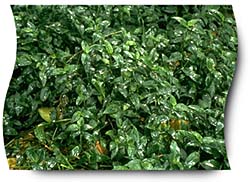|
Invasive weeds - Tradescantia |
|
Invasive weeds - Tradescantia |
What is it?
Tradescantia fluminensis is a ground-cover plant with
succulent stems capable of tolerating low light levels.
Although this plant produces a small white flower it does not
reproduce from seed, but only from stem segments. That means that
small pieces of stem left lying on the ground will start new
plants.

The plant is named for John Tradescant - gardener to King Charles I of England. English books say that is very easily propagated by cuttings or pieces of stems at any time of year. Like many introduced plants it has taken off in New Zealand conditions and has become a pest.
Why is it a problem?
Tradescantia is a special problem because of the way it can
thrive in low light areas. It can form a dense mat under forest
trees, which smothers low-growing plants and prevents the natural
regeneration of taller native species. If left unchecked it can lead
to the non-replacement of forest. When seeds fall to the ground, they
cannot grow because the thick mat of Tradescantia stops the light
getting to the seed.

Methods of control
Manual Control: Small areas can be successfully controlled by
physical removal of the plant. Dense infestations can be raked and
rolled up like a carpet. If the material is not removed it will
resprout. However the plant is frost tender, so dragging it into the
open where it will be exposed to frosts will help. Accessing
Tradescantia to deal with it by mechanical means is often difficult
in the bush, so it needs to be done by hand.
Chemical Control: Common herbicides that are suitable include Grazon, Roundup and Amitrole. Use the concentrations as recommended by the manufacturer. You should spray to wet, but not to drip. The whole plant should be sprayed, and it is also suggested that raked-up piles of the plant should be finished off with a dose of spray.
Repeat sprayings are likely to be necessary, especially in damp gullies. Spray in spring or at the driest time of the year.
Take care to spray only in still conditions to avoid wind drift to non-target plants and don't spray when rain is expected. During spraying, non-target plants can be shielded with cardboard, plastic sheets or a large plastic container.
As with all spraying you should read the instructions on the manufacturer's label closely and always wear protective clothing.
1. Get hold of some tradescantia plants.
(Ask Miss Currie to bring some in for you - she has plenty
growing in her bush!) Look at them carefully and sketch the
plant. 2. Test the information given above that
it grows easily from bits of stem. Break off just leaves,
and bits of stem and leaf, and bits of just stem. Lay them
on moist ground or potting mix, and also on moist paper
towel, and see if they all grow roots, and how easily they
grow. 3. Try just sitting a bit of stem in
water, and see if it grows roots. .
![]() FOLLOWUP
FOLLOWUP